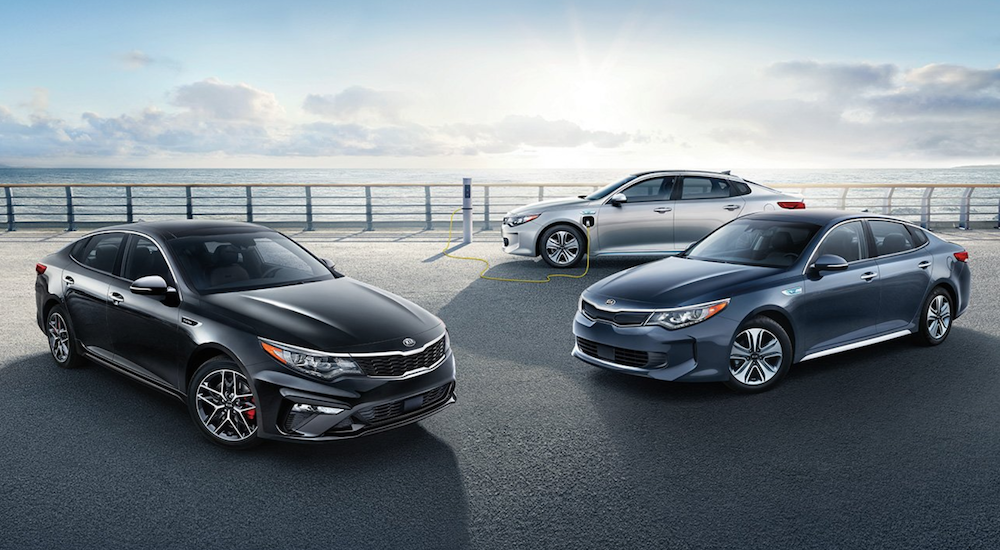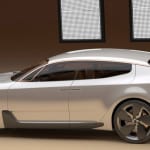Since so many automakers seem content in allowing traditional midsize sedans to be erased from existence, it’s refreshing to shift our attention over to one that’s enjoying some praise right now. And while nearly twenty years and nearly four full generations have come and gone since its original introduction, the 2019 KIA Optima feels fresh in its depiction of an offering that has always felt ahead of its time.
In recent years, we’ve seen in-class competitors like the Camry, Accord, and Altima make a big deal out of their redesigns, stressing an aggressive aesthetic which might have previously been beyond their designers’ reach. But a desire to rebrand a sedan with an aggressive look is nothing new, and any credit due to Toyota, Honda, or Nissan feels diminished when we remind ourselves that KIA had almost always designed the Optima inspired by the same sensibilities. In some ways, one could say that KIA had helped to pave the way.
So with five model years under its belt, how well does the current generation of 2019 Optima fare against the expectations placed around it? Well, let’s take a closer look and find out.
The Basics
Priced to start around $22,990 MSRP the 2019 KIA Optima is available in four trim levels (LX, S, EX, and SX) and, depending on the configuration selected, three different powertrains. Seating five, the 2019 Optima is enjoying a refresh consisting of updated exterior design and lighting design, as well as new wheel designs.
It also boasts a wider standardization of driver assist features including (but not limited to) forward-collision warning, automatic emergency-braking, lane-keep assist, lane-departure warning, and a monitor designed to maintain driver attention on the road.
As part of the KIA family, the 2019 Optima comes with a Limited Warranty covering 5-years or 60,000 miles, whichever comes first. With a Powertrain warranty covering 10-years or 10,000 miles, whichever comes first.
Performance
The (base) LX comes powered by a 2.4-liter inline-four cylinder engine paired to a six-automatic transmission capable of 185 hp,178 lb-ft of torque and 35 mpg (highway, 25 city). The Optima S features the same engine configuration. While powertrains differ for each of the trim levels, each one features continuous variable valve timing and direct injection.
Moving along to the Optima EX (starting at $26,890 MSRP) you’ll find a Turbocharged 1.6-liter I4 mated to a 7-speed dual-clutch transmission that churns our 178 hp, 195 lb-ft of torque and 37 mpg (highway, 27 city). And finally, the SX (priced to start at $31,990 MSRP) comes powered by a 2.0-liter of that turbocharged I4 paired off with the 6-speed automatic, delivering 245 hp, 260 lb-ft of torque and 30 mpg (highway, 21 city).
Exterior Design
While there are countless design notes that feed the Optima’s sporty appearance, they’re far more subtle and understated than seen in other competitive options. From the iconic tiger nose grille and front fascia positioned just below the KIA badging, the swept-back appearance of the Optima feeds into its sleek, aerodynamic appearance. Striking, albeit with a sense of refinement, it makes an instant first impression and compels your eye to follow its clean lines backward.
Walk around the Optima, and it’s hard to ignore the sleek, body-hugging contours that contribute to its lithe, athletic aesthetic. Complimented by a low, sloping roofline the Optima is tied up perfectly by the bold angles of its rear fascia. Overall a beautiful design that punches way outside of its weight class.
But one area that the Optima reflects a sense of refinement comes in the selection of available colors. Ultimately, each of the seven exterior colors made available is fairly ordinary. And while some might consider the absence of ‘electric green’ or ‘sunburst orange’-like colors to be a negative, it speaks the Optima’s strength of design that bold colors aren’t needed in order to dress it up.
Interior Design
While the execution differs across trim levels (with some stronger material choices available ‘up the ladder’ in the SX) the core aesthetic of the Optima’s interior seems to have stemmed from the same sporting philosophy that inspired its exterior.
While many of today’s vehicles either utilize flat, horizontal motifs to stretch the cabin outward or curved motifs to create a more intimate cabin experience, the Optima sidesteps such rigid polarity. In some ways the former, in others the latter, it incorporates both in a tasteful and complementary manner that (to be honest) feels fresh by comparison. Combined with the forward/downward stand of the door paneling, your eyes are continually drawn forward to the front of the cabin. This conveys a subtle sense of momentum, lending the Optima a sense of performance credibility.
As alluded to above, the SX trim level offers certain enhancements to the Optima’s cabin experience both in terms of leather upgrades and contrasting two-tone color combinations. The pairing of red & black leather, for example, has proven a popular combination for many automakers in recent years but—especially in an affordably priced car like the Optima – does wonders to enhance both its perceived value and perceived sense of athleticism.
But the well-appointed SX also enjoys enhanced infotainment options, like a 10-speaker Harman Kardon audio system (a considerable step-up from the six-speaker base option) and 8.0-inch touchscreen interface. But regardless of which trim level you select, Apple CarPlay and Android Auto come standard ticking (what are now) the standard boxes.
Hybrid Variants
For those with an eye permanently fixed on sustainability, KIA offers both a Hybrid and Plug-In Hybrid variant of the Optima.
The (traditional) Optima Hybrid is priced to start around $28,090. A 2.0-liter engine (capable of 154 hp) is paired with a 38kW electric motor to create a combined power rating of 192 horse and an estimated 45 mpg (highway, 39 city).
The plug-in version of the Optima Hybrid is eligible for classification as a ‘Clean Air Vehicle’ and is priced to start around $35,390 MSRP. The pairing of a 154 hp 2.0-liter engine and 50kW electric motor deliver 202 hp and 40 mpg combined.
While it’s hardly rare to see hybrid or plug-in hybrid variants of sedans anymore, it’s always refreshing to see an automaker confident enough in their offerings to serve up the powertrain trifecta. As Car and Driver said, “There’s an Optima for every palate, and each flavor has merit.” The Optima is a perfect example of that kind of confidence, and we applaud KIA for it.
Is the KIA Optima Right for You?
While we applaud KIA for creating an offering that isn’t afraid to push the limits of its own identity, the Optima never feels like it’s aspiring too far or losing its sense of self. That, in itself, speaks volumes, assuring us that KIA aimed to create something that was nothing less—and nothing more—than the final product.
But don’t mistake competence and a clear sense of identity for complacency. The availability of a plug-in hybrid variant and teased development of a convertible concept mean that KIA might have bigger plans for the Optima, beyond a midsize sedan or sports-wagon. And judging by the near-continual ascension of sales over its near-twenty year lifespan, well, the Optima feels more popular than ever.





